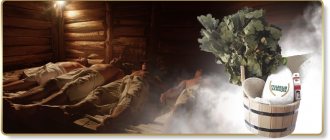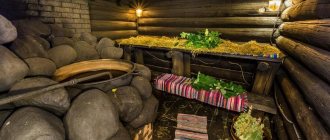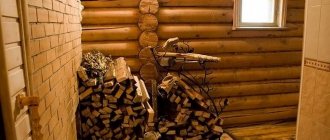The sauna is an amazing stress reliever
It is also important, especially in the current living conditions, that the sauna and Russian bath are excellent sedatives. They will become real antidepressants for the frayed nervous system of modern man. Scientists have found that with regular trips to the sauna, the speed of the body's reactions improves, and balance and coordination of movements are restored.
But in order for the sauna to benefit you and improve rather than ruin your mood, when visiting it you must comply with several requirements.
The whole truth about the Russian bath
Page 1 of 4
For several years I have been helping people build real Russian baths. Over the years, I have clearly understood that in the minds of our bathhouse lovers there is an absolutely perverted concept of “Russian bathhouse”. The many private and commercial bathhouses that are present everywhere in our country and operate under the fashionable sign “Russian wood-fired bathhouse” are very far from a real Russian bathhouse. And, in fact, they are not. The monstrous misconceptions about the Russian bath that firmly sit in the heads of our compatriots prompted me to write this article. The article is written in the form of an interview and is intended to answer the most typical questions about the Russian bathhouse and dispel the myth that those bathhouses that are being built everywhere in our country are real “Russian bathhouses”. And I had the wrong bathhouse before. You can read how I made it into the right one in my article “Converting a turnkey bathhouse into a smart bathhouse”
Nowadays the Russian wood-fired bath has become very popular. Tell us about her.
Russian bathhouse is one of the many types of bathhouses. Its closest sister is the Finnish sauna. But both the Finnish sauna and the Russian bath in their classical guise are now very rare. And those baths that we call Russian baths have nothing to do with this type of baths. Unfortunately, in our country there is a persistent perverted stereotype of the Russian bath. Most of our bathhouse lovers believe that a Russian bathhouse is when the temperature is +100C and above, you can pour water on the stones and whip yourself with brooms. This is fundamentally wrong! The Russian bathhouse is completely different, and few people know about it; even fewer have had the good fortune to take a steam bath in a real Russian bathhouse.
How so? I, too, have always thought that a Russian bath is when it is very hot, there is a lot of steam and you need to be whipped with brooms. All my friends have such baths. Some even steam at +120C.
This is true. The vast majority of private, commercial and public baths have exactly these temperature conditions. And all visitors to these baths are sure that this is a real Russian bath. But that's not true. Nowadays you can find numerous signs “Russian wood-fired bathhouse”. But behind these signs, in fact, is not a Russian bathhouse at all. Unfortunately, it is now very difficult to find a real Russian bathhouse. Everywhere they build and use standard baths and persistently, but erroneously, call them Russian.
It turns out that by hanging a sign “Russian wood-burning bathhouse,” we are being deliberately deceived?
This is not entirely true. The widespread illiteracy of our people in bathing matters has given rise to this situation. I can say with confidence that most owners of commercial bathhouses, bathhouse stores, sellers of bathhouse products, owners of bathhouse websites on the Internet have no idea about the types of bathhouses, the types of stoves for different types of bathhouses, and so on. We trust them, we trust advertising, signboards, or simply the assurances of would-be professionals. But their task is to sell their product or service. The easiest way for them is to hang up a fashionable “Russian Bath” sign, but at the same time not understand or know what it is. All these “specialists” either do not go to the bathhouse at all, or, like the majority of our citizens, mistakenly think that the bathhouse they visit is a real Russian bathhouse. Most of them don’t even think that the service or product they offer has nothing to do with the Russian bathhouse.
So what is a Russian bathhouse?
It is very difficult to define a Russian bath. What is this for a Russian person? A room where they wash and steam? Or is it a complex of wellness procedures associated with steaming, dousing, massage, herbs and teas? Or maybe this is something deeply spiritual and even sacred for a Russian person - a sacred place where not only the body, but also the soul is cleansed, illnesses go away, and strength appears? Lifestyle and good long-term habit? Maybe this is a place for meeting with friends, intimate conversations, discussions and conversations about life? Probably all these definitions are correct. And many more similar definitions can be given. But the point is not in the definition, but in that capacious concept of “Russian bath”, which at the genetic level is so important for the Russian person. Next, we will try to figure out what a proper Russian bath is and how it differs from other types of baths, which are also mistakenly called “Russian baths”. Let's start with the most important thing: the condition in the steam room of the Russian bath. Conditions are the relationships between temperature and humidity.
I always thought that the only thing that matters in a bathhouse is the temperature. The higher it is, the better the bathhouse.
This is not true. Food without salt is absolutely not tasty. But it is also not true that the more salt in food, the tastier it is. The same goes for the temperature in the steam room. It is no secret that the human body is designed in such a way that it is comfortable at certain temperatures. For example, it freezes at temperatures below its own +36.6C, and overheats at higher temperatures. But the degree of comfort is influenced not only by temperature, but also by humidity. For example, severe frosts are more easily tolerated with low air humidity. It feels like frost of -30C in the northern regions is easier to bear than the same frost of -30C in the middle zone. It's just that in the middle zone it is more humid than in the north. It's the same with heat. Lower humidity makes it easier to tolerate higher temperatures. And vice versa. A person is designed in such a way that his body itself tries to regulate body temperature when it finds itself in conditions that are not comfortable for it. At elevated temperatures, we produce sweat, which, when evaporated, cools our body. The lower the humidity, the faster sweat evaporates and the more effectively the body cools. High humidity slows down the process of sweat evaporation and, accordingly, cooling of the body. And our body begins to feel uncomfortable. We also know that if our body catches a virus or just has a cold, it raises our body temperature. The critical temperature of our body is slightly above +40C. Why is he doing this? The fact is that at elevated temperatures it is easier for the body to fight harmful bacteria, and all processes in the body are accelerated. From this we can conclude that a small, controlled and time-limited artificial increase in body temperature will trigger the body’s hidden healing reserves, speed up blood flow, and will not be harmful, but for good. Since ancient times, our ancestors understood that it is useful to sometimes heat the body, but it is not worth overheating the body too much. This is more harmful than useful. That is why the temperature in the Turkish hammam, Roman baths, Japanese ofuro, classic Finnish saunas and classic Russian baths was approximately +40- +45C. Please note, not +100- +120С, but +40- +45С! And this temperature in baths has been used by people for thousands of years, in different cultures, countries and in different climate zones. People have long understood that it is this temperature that has the most beneficial effect on the body and makes it healthier. In the Russian bath, the temperature in the steam room is in the range of +45- +60C, in rare cases +70C. This is the first truth about Russian baths. Since most bathhouse lovers believe that the temperature in a Russian bathhouse should be no less than +100C. What about humidity? In a Turkish hammam it tends to reach 100%, at a temperature of +40C. In a Russian bath, the most comfortable humidity is in the range of 50-70%. At the lowest temperature limit of +45C, the most comfortable humidity will be approximately 65-70%. There is an opinion that the classic conditions in the Russian bath are a temperature of +60C and a humidity of 60%. I don’t entirely agree with this, since the 60/60 condition is quite harsh, and I would not recommend it to novice sauna lovers, women and children. For most non-professional bath lovers, a comfortable mode will be approximately +45- +55C, with a humidity of 60-70%. But all this is very relative, and everyone should choose the conditioning regime that is closest to them. But it should be noted that if the temperature in the steam room is about 50C, and the humidity is too high (80-90%), then, despite the fairly low temperature, this mode will be harsh and not comfortable. Low humidity at the same temperature +50C will also give an uncomfortable regime. It will seem that the steam room is not hot enough. That is why conditions - the correct ratio of temperature and humidity - are extremely important in a steam room of a Russian bath.
Yes, this is truly a discovery for me! But somehow I can’t believe that at a temperature of only +45- +50C you can steam normally. Can real men steam at such a childish temperature?
How can they? Moreover, the degree of steaming of the body in a real Russian bath is much higher than in the so-called “Russian baths”. In a real Russian bath, our body warms up very deeply, in contrast to superficial heating, and sometimes burns of the skin in baths at temperatures of +100C and above. No wonder in Rus' they said “steam to the bones,” that is, as deeply as possible. The fact is that in the steam room of the Russian bath we affect the body not with elevated temperature, but with steam. Naturally, this steam has a temperature much higher than + 45-50C. As an example, I will say that all the lovers of elevated temperatures who visited my bathhouse, and who were initially skeptical about the conditions of the Russian bathhouse, after steaming, thought about their old preferences and asked me for advice on converting their steam rooms with temperatures from +100C and above into a real one. Russian bathhouse. It happened like this. At the very peak moment of steaming, I ask them: what, in your opinion, is the temperature in the steam room now? They always answer that there is definitely +100C. And then I usually show them the thermometer. And it’s only +50C! This amuses me, but experienced bathhouse lovers with extensive experience of steaming at temperatures above +100C are thrown into a stupor from a lack of understanding of what is happening. So, given the conditions of the Russian bathhouse, even a bathhouse lover with extensive experience in visiting hot steam rooms can be perfectly steamed. Many will not take my word for it, but to believe it, you have to try it. Or simply trust our ancestors, who from time immemorial steamed at precisely these temperatures.
What then are the typical bathhouses built everywhere? From private to commercial? What should we call them then and what modes are there?
Those baths that are now being built everywhere cannot be called classic Russian baths. This is a new type of bathhouse that came to us after the revolution of 17. It’s no longer a sauna, but it’s not yet Russian either. The exact name for such baths has not yet been invented. As I said above, they continue to stubbornly be called Russian baths. I call these baths New Russian baths. Or dry air baths.
What are their main differences from the classic Russian bath?
First of all, the temperature in such baths usually lies in the range of +90- +130C. As I said above, in order for our body to withstand such temperatures, it is necessary to lower the humidity to 10-30%. Otherwise, the body will receive thermal burns or simply be cooked. To heat the steam room to such temperatures, metal sauna stoves with an open heater are used. The stones in them lie on a heated surface and are not covered with anything on top. Such a metal stove heats the steam room quite quickly due to air convection. That is, the air in such steam rooms constantly circulates, heating up from the stove and rising to the ceiling already very hot. And so in a constant cycle. The air movement in such steam rooms is quite strong and does not stop throughout the entire length of the bath. The walls of the metal furnace also overheat, and due to active temperature infrared radiation, the surfaces of the steam room are constantly heated. Steaming (from the word “steam”) in such baths is problematic. Rather, they simply drive hot air with a broom. Apply a fairly small amount of water (100-500g) to the stones. Turning into steam, due to the extremely low humidity in the steam room, it is almost instantly absorbed into the overdried wood. The amount of this steam is extremely small. But the steamers still manage to capture some of this steam with a broom and draw it onto themselves. And this is at such high initial temperatures, exposing your body to serious overloads, up to thermal burns of the skin or mucous membranes.
It's clear. That is, the main differences are higher temperatures and lower humidity. But are such baths also good for health or not?
Here I am forced to disappoint the avid steamers in the Dry Air Baths. Not only do they not add health, but sometimes they even take it away.
Why?
In the Dry Air steam rooms there is a very high, extreme temperature for our body. It begins to actively sweat in defense. But since the humidity is still quite high, especially since we have a tradition of pouring water on stones, the evaporation of sweat and cooling of the body does not keep pace with the rate of its heating. The body begins to overheat very quickly. Note, not to heat up, but to quickly overheat. Therefore, you can stay in the Dry Air steam rooms for 5-10 minutes. No more. And, obviously, during this time the body simply does not have time to warm up deeply. Place a piece of meat in the oven for 5 minutes at +120C. Cut it and see how hot this piece gets. It will only be warm at a depth of a few millimeters from the surface. So there is no benefit to the body from such “warming up”. The main meaning of the bath is crossed out - deep warming of the body. But our compatriots go further in torturing their bodies in the Dry Air steam rooms. They actively pour water on the stones. This significantly increases the humidity in the steam room for a short period of time. And we have already said that high temperatures with high humidity are extremely uncomfortable for our body. It begins to turn on protective functions. Sweat does not have time to evaporate and cool the body, our brain literally screams at us - run away from here! For many steamers, the whole thrill of steaming lies, to a greater extent, not in being in the steam room, but in the moment of leaving, or rather running out of it. They see a certain courage in this. And your body, exhausted by overload, sees salvation from inevitable overheating. Moreover, a sharp jump in humidity at high temperatures has a very negative effect on the mucous membrane of our body. In extreme conditions and under very harmful influences, the eyes, throat, lungs, and nasopharynx are exposed. Often there are injuries. Regular visitors to such baths often boast that they steamed so hard that they burned their nose or throat. At the moment of serving on the heater, all visitors to the steam room, escaping from the scalding wave of steam, pull their heads into their necks, bend down, quack, and wince. Some wrap themselves in a towel. At the same time, thinking that they are so cool that they can experience such overloads at the limit of their body’s capabilities. And they are not afraid of possible burns, dizziness, or headaches after the bath. The metal surfaces of the sauna stove, heated to very high temperatures, also play a negative role. They emit very harsh infrared radiation that is not comfortable for our body. Our body, falling into this radiation, begins to practically fry. This is exactly how the grill in which chicken is fried works. But the whole benefit of baths lies in the deep warming of the body. Here we don't get that at all. But we end up with harm to our organs and personal pride for steaming in such a hot steam room. Many people do not like to go to the bathhouse precisely because of these uncomfortable conditions. They say it’s very hot, stuffy, and there’s a headache. Everything is correct. The body resists harmful effects. I highly recommend visiting a real Russian bathhouse for such people. And the whole bathhouse world in their heads will turn upside down. You will understand that a bathhouse is very pleasant, comfortable and good. No stuffiness, unbearable heat, headaches, or burning wooden surfaces in the steam room. Only benefits for the body. Due to the fact that the process of soaring in dry air steam rooms, due to its extreme nature and harmful load on the body, cannot be a pleasant, relaxing and peaceful pastime. Due to the fact that in the steam room of such baths it is impossible to get that same bath pleasure, it is replaced with billiards, karaoke, drinking and other joys of life. In good steam rooms of a Russian bath, a person enjoys the bathing process itself, and this is usually quite enough for him.
So why are there such extreme and unhealthy baths everywhere? How did we get them?
There are many different versions of why the Russian people turned away from their traditional centuries-old bathhouse towards the Dry Air Steam Baths. I will voice my version. The transition from the traditional bathhouse began to occur in troubled revolutionary times. Devastation and hunger paid special attention to hygiene. The bathhouse began to be used as a washing and washing station. Just a couple of decades ago, in any public bathhouse you could see visitors washing their clothes en masse. Traditional brick stoves or black baths required a lot of time for heating, a large amount of firewood and constant repairs. Metal stoves quickly warmed the steam room and heated large quantities of water. This is exactly what was needed at that time. Then the war began, and the bathhouse continued to serve its hygienic function. After the war, massive construction began. Workers needed to be washed quickly and cheaply. And again metal stoves saved the situation. The water heated up quickly, although the temperatures in the steam room increased sharply. But this did not frighten anyone. Citizens waved brooms out of habit, and a trip to the bathhouse was considered happiness. Further, in an era of total shortage, there were a lot of skilled welders who made sauna stoves from a piece of steel pipe. Due to their design, they also quickly overheated the steam room, but generations who grew up in the heyday of the New Russian baths already considered this the norm. In the baths they also mostly washed and washed their clothes, but a new bath culture began to emerge. Gatherings with beer in public baths, films with scenes in baths, literature. The first books, “How to Build a Bathhouse Yourself,” naturally described stoves made from scrap materials—metal. Electricity has become cheap and accessible. Public baths with electric metal stoves appeared. In villages in northern Russia, fortunately, the bathing traditions of the Russian bath have been preserved. But in the south of Russia, metal stoves still prevail, designed more for heating water than for producing steam. They are still in everyday use called not stoves, but boilers. In the 90s, saunas began to appear en masse. It was fashionable and profitable. Nobody knew what a sauna was. They installed the same metal stoves, which greatly overheated the steam room, hung up a “sauna” sign, and money flowed to the owners like a river. At the same time, the opinion arose in the minds of Russians that the sauna is debauchery and vice. And also that the bathhouse (sauna) must have a swimming pool, billiards, karaoke, beer and women. Another bath (sauna) culture was born. But the steam room conditions remained the same: +100C and above. Our citizens no longer perceived other regimes as a bathhouse. Now there is a massive change of “Sauna” signs to the now fashionable “Russian wood-fired bathhouse” sign. But the most amazing thing is that nothing changes inside such baths! The ovens remained the same. The conditions remained the same. But, judging by the sign, the type of bathhouse has changed. It's funny, isn't it? Private owners began to build identical bathhouses “like everyone else’s”, copying typical mistakes, but without seeing them. Stoves for dry air baths filled the stores. True, they sell them as stoves for Russian baths, but let’s leave that to the conscience and illiteracy of the sellers. All skilled welders and home-made workers also “produce” stoves from scrap materials only for Dry Air steam rooms. People began to steam in large numbers in the bathhouses “like a neighbor’s” and firmly believe that this is a real Russian bathhouse. At the same time, putting your health at risk and not getting from the bath what it was invented for - deep warming of the body. Many people build their own bathhouse to get those regimes that they remember from childhood: the soft regimes of the Russian bathhouse, as their grandfather had in the village a long time ago. But for some reason it is impossible to feel such regimes in a newly built bathhouse. Although a lot of money was invested in the bathhouse, the most expensive materials and a branded stove were used. This happens because all those numerous teams that are supposedly building “Russian baths” throughout the country have no idea about the real Russian bath. And they end up with miserable Dry Air steam rooms. Cheap and fast. And a lot of sites on the Internet that are ready to teach you how to build a real Russian bathhouse are complete nonsense. The sites that provide truthful, useful and correct information about the Russian bath can be counted on the fingers of one hand. Specialists in Russian baths are generally a rarity. But they exist, and real Russian baths are still being built. But, unfortunately, there are very few of them. That is why dry air steam rooms are being massively built and operated in Russia.
- Back
- Forward >>
How to become more attractive with the help of baths and saunas?
Cosmetic procedures in baths and saunas have always been in demand. It is known that in ancient times, village girls used decoctions and infusions of various herbs to rinse their hair, and washed their faces with milk and buttermilk after visiting the steam room.
Today, there are also ready-made cosmetics for baths on sale, but still more interest is attracted to natural, home-made mixtures, masks and scrubs, which allow you to carry out full-fledged SPA procedures in a bath - both Russian and Finnish.
So, how is a beauty bath used? Here are just a few of the effects that you can get when visiting a bathhouse:
- cleansing and rejuvenating the skin, fighting pimples and acne;
- weight loss, getting rid of cellulite;
- improvement of hair condition.
To some extent, all procedures in the bathhouse have this effect. But it intensifies with the use of appropriate means.
For hair beauty
Both dry and wet steam have a beneficial effect on the condition of the hair. This happens because steam increases blood circulation throughout the entire scalp, including in the area of the hair follicles. If you combine thermal procedures with masks or decoctions, you can easily make your hair shiny, strong and healthy.
The most effective addition would be:
- Olive or burdock oil.
- Chicken yolks.
- Gelatin solution.
- Decoctions of herbs (chamomile, nettle, birch and linden leaves, burdock root).
- Juice (or pulp) from aloe leaves.
- Honey.
- Brewer's yeast (this is the official remedy for hair loss).
- Cream, kefir, whey or buttermilk.
- Coffee grounds.
- Peach puree.
All these components combine well with each other, so they can be used in combination.
For clear and smooth skin
The most popular bath procedures for the beauty and health of the skin are various types of cleansing using peeling, scrub, and cosmetic masks.
It is convenient to use as a scrub:
- coarse sea salt - it will remove the top layer of the epidermis and help cope with inflammatory elements;
- coffee grounds are a favorite among means for cleansing and fighting cellulite;
- baking soda - it is especially useful for oily, acne-prone skin.
Also used: brown sugar, candied honey, a mixture of liquid honey with semolina and lightly steamed oatmeal. All of them exfoliate dead epidermis well and clean out pores. It is enough to visit the steam room once to open the pores and prepare the skin for cleansing, and then rinse and use the scrub. The effect of complete renewal is guaranteed!
A good addition to the scrub would be cosmetic masks from:
- white and blue clay;
- sour cream or cream;
- citrus fruits;
- fresh cucumbers;
- activated carbon and gelatin;
- berry puree.
With the help of masks you can create a real SPA in the bathhouse. Berries and fruits will have an effect due to fruit acids. Contain acid and fermented milk products; In addition, they saturate the skin with vitamins and microelements. Fresh cucumber tones, and clay and masks with activated carbon are very good at removing impurities and removing unnecessary substances.
Such bath procedures are also good for skin rejuvenation. By cleansing it of toxins and waste, nourishing it with useful substances, you can create favorable conditions for self-healing and cell renewal.
Since all muscle groups, without exception, relax under the influence of steam, it can also be used to eliminate facial wrinkles. Therefore, bath procedures are very useful for women who are on the verge of the appearance of the first age-related changes.











